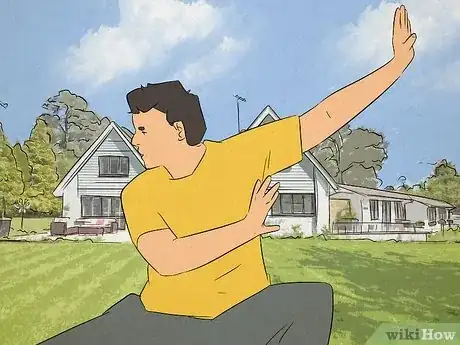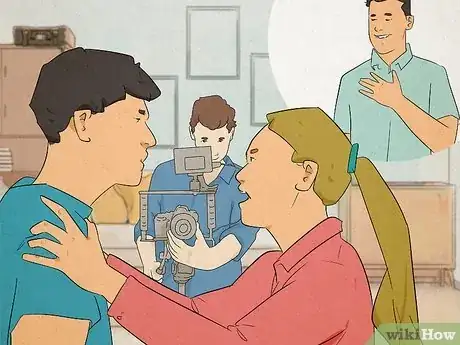This article was co-authored by Ben Whitehair. Ben Whitehair is a Social Media Expert and the Chief Operating Officer (COO) of TSMA Consulting. With over a decade of experience in the social media space, he specializes in leveraging social media for business and building relationships. He also focuses on social media’s impact on the entertainment industry. Ben graduated summa cum laude from The University of Colorado at Boulder with BAs in Theatre and Political Science as well as a Leadership Certificate. In addition to his work as CIO, Ben is a certified business and mindset coach and National Board Member of SAG-AFTRA. He is also a successful entrepreneur as the Co-Founder of Working.Actor, the premier business academy and coaching community for actors.
wikiHow marks an article as reader-approved once it receives enough positive feedback. In this case, several readers have written to tell us that this article was helpful to them, earning it our reader-approved status.
This article has been viewed 139,876 times.
Method acting is a famous acting technique that requires one to deeply embody their character. Learning how to method act requires a commitment to the process and a consistent practice schedule. However, the more you spend time practicing skills and techniques, the quicker you will be able to be in character and the better you will be able to perform. There are many resources and exercises that can help you achieve your desired level of method acting.
Steps
Finding Resources
-
1Enroll in a method acting institution. Enrolling in an institution that specializes in method acting will provide you with classes, resources, and information about the history and techniques of method acting. Most programs also offer hands-on experience through class led performances as well as school wide performances. Another benefit of enrolling in a method acting program is the community of others who share similar interests, which can lead to further developments in your acting.
- The Lee Strasberg Theater and Film Institute is the founding method acting institution.
- You can also try reading original books by Konstantin Stanislavski, the creator of the method.[1]
-
2Take acting classes. There are many local classes available that do not require you to be enrolled in an acting school. Classes that are not institutionally associated can also have a wide variety of skill levels and interests creating a more diverse environment. Taking classes will allow you to get more professional advice and information about method acting without having to manage going to school while having other obligations.
- Look for classes and teachers who teach method acting through online acting resources, like takelessons.[2]
Advertisement -
3Connect with your local theater community. Your local theater community can be another useful resource for learning and discussing method acting and its techniques. Local theater communities are often made of individuals who are not professional actors and are still learning new skills and techniques.
- Reach out to the head of your local theater and see what resources they offer. Ask them questions like, “I’m trying to learn method acting, do you have any advice?” “Do you offer any classes or resources on method acting?” or “Are there rehearsals that are open to the public?”
Practicing Method Acting Exercises
-
1Start with relaxation. Relaxation is the key principle of method acting, which allows you to fully enter your role and perform to the best of your ability. Spend time relaxing before trying any exercises or acting scenes. Try to relax each part of your body individually at slow increments. The more relaxed you are the more you will be able to employ the techniques of method acting.
- T’ai Chi is a great practice to adopt for relaxing your entire body in a methodical and contemplative way.[3]
- Try meditation or yoga techniques to further relax your body and mind before warming up and practicing your method acting.
-
2Use sense memory and concentration. Sense memory is the practice of trying to tap into memories of your senses: sight, smell, sound, touch, and taste. Try thinking of a memory and concentrating on the different sensory experiences of that memory. One popular exercise that has to do with using sense memory is called the “personal object exercise,” which has the student explore an object that has personal significance to them with each one of their senses.
- Sense memory takes a lot of concentration and patience. Remember to practice slowly and not rush yourself. Give yourself time to fully explore your memory or object.
-
3Think about your own emotional memories. This exercise is generally for more experienced method actors as it can often be triggering or overwhelming. The purpose of thinking about your own personal emotional memories is to use your sense memory to be able to explore a personal memory and use that emotion in another character.[4] For example, if the character you are trying to play has experienced loss, you would think about a memory in which you experienced loss and explore it using all of your senses.
- Only perform this exercise with an experienced teacher if you are new to method acting and have not used your own emotional experiences in exercises.
- You're going to become a more interesting actor as you get older because you'll have laughed, loved, hurt, and lived more. This means your emotional well of experiences to draw from will be deeper.[5]
-
4Try and embody your subject. Embodying your subject, or characterization, is the practice of imagining yourself as someone or something else. Spend time observing your subject and how they engage with their surroundings before you begin this exercise. After observing your subject use your sense memory to begin to explore your environment in the ways your subject would.
- Try choosing an animal as your first subject if you haven’t practiced this exercise before. Choosing an animal will help exaggerate the techniques used in this exercise.
-
5Play games that use method acting techniques. There are many games that employ the techniques required to successfully perform method acting. Games that use method acting techniques will allow you to externalize the skills the techniques are aiming to teach you. Try playing a game at the end of each practicing session to try out new skills and refine old ones.
- Many websites for method acting classes also offer examples of games that can be played that use method acting techniques.[6]
- Be prepared for the lessons to be intense. For instance, the world-class training for the Meisner technique is supposed to be done twice a week, two hours per class, over a two-year period.[7]
Using Your Skills
-
1Use sense memory exercises to better understand your character. Sense memory exercises will help you recreate and inhabit emotional spaces that can comprehensively account for all of the senses. When you know who or what your character is, like a recently divorced husband, a little girl on her fourth birthday, or a werewolf, use sense memory exercise to better understand that characters’ environment.[8]
- For example, if your character is a werewolf, try to use sense memory to explore each different sensory experience from the perspective of a werewolf.
-
2Think about your own emotional memories to perform realistically. Use your own emotional memories during your performances to deliver more realistic responses and reactions. It can seem contradictory to use your own memories when trying to stay in character, but the goal of this exercise and tool is to use your own memories while you are in character. The more you use your own emotional memories in sense memory exercises the easier it will be to conjure these emotions up during performances.
- Try to create relationships between memories and emotions. For example, if your character needs to express anxiety over being fired, try to use the same memory each time to conjure that anxiety.
-
3Embody your character. Embodying your character while they are moving around set, doing gestures, or using mannerisms while speaking will give your character a comprehensive realism. Embodying your character will help even the most minor and peripheral movements and postures reflect the realist emotion and performance possible.
- Embodying your character is what most people refer to as “getting into character,” which does ultimately happen before the performance begins. Try to give yourself a large margin between when you get into character and when you perform, like one hour.
-
4Remember to stay relaxed. Remember to practice your relaxation exercises before any exercises or performances. Relaxation is fundamental to method acting and these emotional states cannot be realized without relaxation. Be sure to give yourself plenty of time to relax before exercises or performances, like 1-2 hours.
Expert Q&A
-
QuestionWhat is the method acting technique?
 Jim JarrettJim Jarrett is an Acting Teacher and the Founder of The Meisner Technique Studio based in San Francisco, California. With over 30 years of experience, he specializes in teaching The Meisner Technique and is Sanford Meisner's last teaching protégé. Over the years, Jim has established schools in Los Angeles, California, Hawaii, and Sun Valley, Idaho. He also travels the world annually as a guest teacher at universities, performing art schools, and theater companies throughout North America, Europe, and Asia. His flagship school is located in the heart of the Presidio in San Francisco, California.
Jim JarrettJim Jarrett is an Acting Teacher and the Founder of The Meisner Technique Studio based in San Francisco, California. With over 30 years of experience, he specializes in teaching The Meisner Technique and is Sanford Meisner's last teaching protégé. Over the years, Jim has established schools in Los Angeles, California, Hawaii, and Sun Valley, Idaho. He also travels the world annually as a guest teacher at universities, performing art schools, and theater companies throughout North America, Europe, and Asia. His flagship school is located in the heart of the Presidio in San Francisco, California.
Acting Teacher Method acting involves becoming so part of your character that you don't need to think about anything else when you're performing. For instance, to get into character for a real-life character, you might read all the biographies available on that character. After putting together a picture of how they spoke, walked, and dressed, you would begin mimicking those mannerisms and layering them into your performance. At first it would be technical and mental, but eventually it would hopefully become natural.
Method acting involves becoming so part of your character that you don't need to think about anything else when you're performing. For instance, to get into character for a real-life character, you might read all the biographies available on that character. After putting together a picture of how they spoke, walked, and dressed, you would begin mimicking those mannerisms and layering them into your performance. At first it would be technical and mental, but eventually it would hopefully become natural. -
QuestionHow do we memorize lines?
 Community AnswerSame as regular actors - reading, repeating, and practicing the role. Just be in-character when you do it and get into it, as though the words are coming naturally from you. Be conscious of what the character is thinking/feeling and their motivations.
Community AnswerSame as regular actors - reading, repeating, and practicing the role. Just be in-character when you do it and get into it, as though the words are coming naturally from you. Be conscious of what the character is thinking/feeling and their motivations. -
QuestionWhich role should I take?
 Rahul SolankiCommunity AnswerAny role cane be taken, even small roles can be memorable if acted with passion. Experiment. After playing some different roles you will better know which roles you are performing well and should pursue.
Rahul SolankiCommunity AnswerAny role cane be taken, even small roles can be memorable if acted with passion. Experiment. After playing some different roles you will better know which roles you are performing well and should pursue.
References
- ↑ Jim Jarrett. Acting Teacher. Expert Interview. 28 April 2020.
- ↑ https://takelessons.com/performing-arts/method-acting-lessons
- ↑ Ben Whitehair. Acting Coach. Expert Interview. 3 June 2021.
- ↑ Ben Whitehair. Acting Coach. Expert Interview. 3 June 2021.
- ↑ Jim Jarrett. Acting Teacher. Expert Interview. 28 April 2020.
- ↑ http://takelessons.com/blog/drama-games-for-method-acting
- ↑ Jim Jarrett. Acting Teacher. Expert Interview. 28 April 2020.
- ↑ http://www.backstage.com/advice-for-actors/resources/8-acting-techniques-and-stars-who-swear-them/












































































